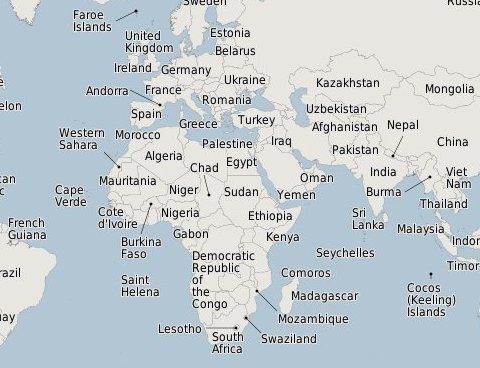MS RFC 81: Offset Labels with Leader Lines¶
- Date:
2011/12/15
- Author:
Thomas Bonfort
- Contact:
tbonfort at terriscope.fr
- Status:
Adopted
- Version:
MapServer 6.2
1. Overview¶
Current labelling schemes place label text at the proximity of the point they are attached to. In the labelcache phase, depending on the label’s POSITION, either one or nine label positions are tested, and the label is discarded if all of these positions cause a collision with the already rendered labels.
This RFC proposes to extend the number of positions that are tested for a given label, and evetually render a leader line from the rendered text to the actual position the label is attached to.
An example rendering of the proposed change can be:
2. Proposed Technical Change¶
The labelcache code will be extended to test for extended labelling positions if the label was configured with “leader” parameters. There will be two configuration options that specify how the offsetted positions are determined:
LEADERMAXDISTANCE will determine the maximum distance that the label text can be placed from its original anchoring position
LEADERGRIDSTEP will determine the step in pixels between each tested position.
If a label cannot be placed due to a collision with an existing label or marker, alternate positions are sampled for by iterating further and further away from the original label point. In the figures below, “X” represents the original label point, “.” represents an individual pixel, “0” represents an offset that has already been tested for in a previous iteration, and “1”,”2”,”3”, represents the order in which the positions are tested for in the current iteration.
1st iteration:
2...1...2
.........
.........
.........
1...X...1
.........
.........
.........
2...1...2
second iteration:
3...2...1...2...3
.................
.................
.................
2...0...0...0...2
.................
.................
.................
1...0...X...0...1
.................
.................
.................
2...0...0...0...2
.................
.................
.................
3...2...1...2...3
third iteration:
3...2...2...1...2...2...3
.........................
.........................
.........................
2...0...0...0...0...0...2
.........................
.........................
.........................
2...0...0...0...0...0...2
.........................
.........................
.........................
1...0...0...X...0...0...1
.........................
.........................
.........................
2...0...0...0...0...0...2
.........................
.........................
.........................
2...0...0...0...0...0...2
.........................
.........................
.........................
3...2...2...1...2...2...3
For each offsetted position, the actual position of the text is adapted depending on the general direction of the offset (e.g. with position “uc” for a label at the vertical of the original point, “ur” for the top right diagonal, etc…)
The iterations stop once an offset position does not cause a collision with the existing labels, in which case the label text is sent down to the rendering backend, or once the first offseted position is further away than the configured LEADERMAXDISTANCE.
The collision detection functions will be extended to account for these added constraints:
A label cannot collide with an existing leader line, and a leader line cannot collide with an existing label. Note that these collision detections operate on the bounding box of the label itself, without taking the label BUFFER into account (i.e. a leader line is allowed to cross the buffer area around an existing label)
A leader line cannot intersect another leader line.
A label who’s original position is inside the edge_buffer cannot be offseted, as this would cause rendering artifacts for tiled output.
If an offseted label has been placed, a line between the original and the offseted position is rendered with the label style(s) that has(ve) the “LABELLEADER” geomtransform.
2.1 Expected issues¶
With RFC77’s multiple labels per feature, the offset should be applied as a whole to all the labels of the feature. In this sense, the leader parameters should be owned by the classObj and not the labelObj, which is semantically awkward.
For labels with LABELPNT geomtransform, should the marker be rendered at the original label point, or at the position the label was offseted to? This probably calls for an additional label style geomtransform.
This functionality is computationally expensive as the label collision functions are called much more frequently than beforehand. The gridstep and maxdistance parameters allow to cut down the number of iterations and therefore the number of times the collision detection is called, at the expense of missing out some potential correct offseted positions. Note that with a gridstep of 1 and a maxdistance of the size of the image, there is the potential that every pixel in the image be tested for collisions. Reasonable values are a gridstep of 5 pixels, and a maxdistance of 30 pixels.
3. Implementation Details¶
A function will be added in maplabel.c to test the configured offsetted positions for a labelcache member against the already rendered labels. A configuration option (TBD) will be added, and this function will be called:
either immediately once a label hasn’t been successfully rendered on its original position
either after a label priority loop has finished. In this case, the function will be called for all unsuccessful labels of the current priority phase.
The labelcache member objects will have two members added, namely a lineObj containing the leader line, and a shapeObj representing the unbuffered label’s bounding box.
The functions that test for collision with existing labels will be extended to check for intersections between leader lines and unbuffered existing labels.
3.1. Files Affected¶
mapserver.h: additional members for labelcachememberobj and labelobj
mapfile.c, maplexer.*, mapcopy.c : parsing and utility functions
maplabel.c: additional collision tests in msTestLabelCacheCollisions
mapdraw.c:
function for trying a label at offset positions
calls to this function in msDrawLabelCache
3.2 Bug ID¶
4. Backwards compatibility issues¶
None expected, new functionality.
5. Error reporting¶
No additional error reporting aside from parsing errors.
6. Example Usage¶
TBD.
7. Voting history¶
+1 from ThomasB, MikeS, SteveW, DanielM, SteveL, JeffM, PerryN and TamasS


